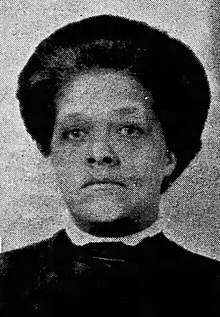Ione Wood Gibbs
Ione Elveda Wood Gibbs (c. 1871 – June 1923) was an American educator, journalist, and clubwoman. She served as vice-president of the National Association of Colored Women from 1912 to 1914.
Ione Wood Gibbs | |
|---|---|
 Ione E. Wood Gibbs, from a 1910 publication | |
| Born | Ione Elveda Wood c. 1871 Burlington, New Jersey, U.S. |
| Died | June 1923 Minneapolis, Minnesota, U.S. |
| Nationality | American |
| Other names | Ione E. Wood, Ione E. Gibbs (after marriage) |
| Occupation | Journalist, clubwoman |
| Years active | 1888–1914 |
Early life
Ione Elveda Wood was born in Burlington, New Jersey, the daughter of George Wood and Emma Simmons Wood.[1] She attended high school in Atlantic City. Her uncle William J. Simmons was the president of Kentucky Normal and Theological Institute, so she attended that school and trained as a teacher, earning her degree in 1888.[2]
Career
Wood was an instructor at the Kentucky Normal and Theological Institute while she was still a teenage student there. She wrote freelance articles, and from 1888 to 1891 was on the editorial staff of Our Women and Children, a Baptist women's magazine run by her uncle.[2] "Miss Ione E. Wood ranks today among the foremost of our women", commented one contemporary writer, "first, from the standpoint of acknowledged intellectual ability to write; second, as an earnest educator and race advocate".[3]
After marriage, Gibbs was active in the Ada Sweet Pioneer Club, a literary and musical club in Minneapolis.[4] In 1905, she served as the first president of the Minnesota State Federation of Afro-American Women's Clubs, after black women's groups were refused membership in the existing Minnesota Federation of Women's Clubs.[5][6] From 1912 to 1914, she was vice-president of the National Association of Colored Women.[1][7][8] She wrote an essay, "Woman's Part in the Uplift of the Negro Race" (1907), which was published nationally, and is still occasionally reprinted.[9]
Personal life
Wood married restaurant owner Jasper Gibbs in 1890. They had five sons: Jasper, Hiram, Morris, Mark, and Wendell. They resided in Minneapolis.[10][11] Wood died in 1923.[12]
References
- Frank Lincoln Mather, ed., Who's Who of the Colored Race (1915): 114.
- Irvine Garland Penn, The Afro-American Press and Its Editors (Willey & Company 1891): 410–413.
- Monroe Alphus Majors, Noted Negro Women: Their Triumphs and Activities (Donohue and Henneberry 1893): 237.
- Donald Ross, "African American and Jewish Women's Clubs in Minnesota" Reading, Meeting and Reforming: Women's Study Clubs in Minnesota, 1880–1942
- "Form Own Society" The Saint Paul Globe (February 9, 1905): 2. via Newspapers.com
- "State Federation" The Appeal (August 3, 1907): 3. via Newspapers.com
- "Mrs. Ione Gibbs Visits Des Moines" The Bystander (March 21, 1913): 1. via Newspapers.com
- "National Association of Colored Women Hampton Meeting" African Methodist Episcopal Church Review (October 1912): 166.
- Ione E. Gibbs, "Woman’s Part in the Uplift of the Negro Race" The Colored American Magazine (March 1907): pp. 264–267; in Teresa Zackodnik, ed., Black Feminist Organizing (Routledge July 2007). ISBN 9780415395373
- ”Minneapolis” ‘’The Appeal’’ (August 23, 1890): 1. via Newspapers.com
- "A Fantasy in Iron" Hennepin History Museum Blog (January 9, 2018).
- "Mrs. Ione E. Gibbs, Prominent Club Woman, Dies in Minneapolis" The Appeal (June 16, 1923): 1.